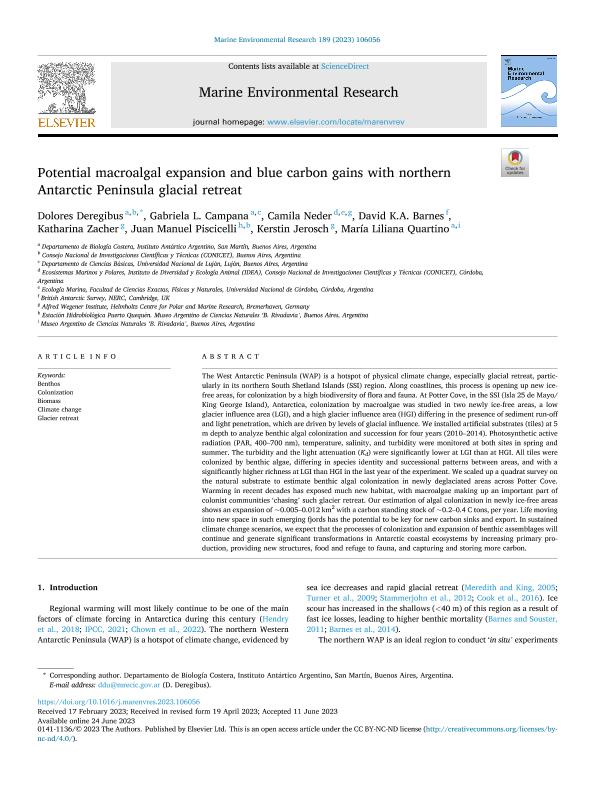Artículo
Potential macroalgal expansion and blue carbon gains with northern Antarctic Peninsula glacial retreat
Deregibus, Dolores ; Campana, Gabriela Laura
; Campana, Gabriela Laura ; Neder, Camila
; Neder, Camila ; Barnes, David K.A.; Zacher, Katharina; Piscicelli, Juan Manuel
; Barnes, David K.A.; Zacher, Katharina; Piscicelli, Juan Manuel ; Jerosch, Kerstin; Quartino, Maria Liliana
; Jerosch, Kerstin; Quartino, Maria Liliana
 ; Campana, Gabriela Laura
; Campana, Gabriela Laura ; Neder, Camila
; Neder, Camila ; Barnes, David K.A.; Zacher, Katharina; Piscicelli, Juan Manuel
; Barnes, David K.A.; Zacher, Katharina; Piscicelli, Juan Manuel ; Jerosch, Kerstin; Quartino, Maria Liliana
; Jerosch, Kerstin; Quartino, Maria Liliana
Fecha de publicación:
07/2023
Editorial:
Elsevier
Revista:
Marine Environmental Research
ISSN:
0141-1136
Idioma:
Inglés
Tipo de recurso:
Artículo publicado
Clasificación temática:
Resumen
The West Antarctic Peninsula (WAP) is a hotspot of physical climate change, especially glacial retreat, particularly in its northern South Shetland Islands (SSI) region. Along coastlines, this process is opening up new ice-free areas, for colonization by a high biodiversity of flora and fauna. At Potter Cove, in the SSI (Isla 25 de Mayo/King George Island), Antarctica, colonization by macroalgae was studied in two newly ice-free areas, a low glacier influence area (LGI), and a high glacier influence area (HGI) differing in the presence of sediment run-off and light penetration, which are driven by levels of glacial influence. We installed artificial substrates (tiles) at 5 m depth to analyze benthic algal colonization and succession for four years (2010–2014). Photosynthetic active radiation (PAR, 400–700 nm), temperature, salinity, and turbidity were monitored at both sites in spring and summer. The turbidity and the light attenuation (Kd) were significantly lower at LGI than at HGI. All tiles were colonized by benthic algae, differing in species identity and successional patterns between areas, and with a significantly higher richness at LGI than HGI in the last year of the experiment. We scaled up a quadrat survey on the natural substrate to estimate benthic algal colonization in newly deglaciated areas across Potter Cove. Warming in recent decades has exposed much new habitat, with macroalgae making up an important part of colonist communities ‘chasing’ such glacier retreat. Our estimation of algal colonization in newly ice-free areas shows an expansion of ∼0.005–0.012 km2 with a carbon standing stock of ∼0.2–0.4 C tons, per year. Life moving into new space in such emerging fjords has the potential to be key for new carbon sinks and export. In sustained climate change scenarios, we expect that the processes of colonization and expansion of benthic assemblages will continue and generate significant transformations in Antarctic coastal ecosystems by increasing primary production, providing new structures, food and refuge to fauna, and capturing and storing more carbon.
Palabras clave:
BENTHOS
,
BIOMASS
,
CLIMATE CHANGE
,
COLONIZATION
,
GLACIER RETREAT
Archivos asociados
Licencia
Identificadores
Colecciones
Articulos(IDEA)
Articulos de INSTITUTO DE DIVERSIDAD Y ECOLOGIA ANIMAL
Articulos de INSTITUTO DE DIVERSIDAD Y ECOLOGIA ANIMAL
Articulos(MACNBR)
Articulos de MUSEO ARG.DE CS.NAT "BERNARDINO RIVADAVIA"
Articulos de MUSEO ARG.DE CS.NAT "BERNARDINO RIVADAVIA"
Articulos(SEDE CENTRAL)
Articulos de SEDE CENTRAL
Articulos de SEDE CENTRAL
Citación
Deregibus, Dolores; Campana, Gabriela Laura; Neder, Camila; Barnes, David K.A.; Zacher, Katharina; et al.; Potential macroalgal expansion and blue carbon gains with northern Antarctic Peninsula glacial retreat; Elsevier; Marine Environmental Research; 189; 106056; 7-2023; 1-12
Compartir
Altmétricas



